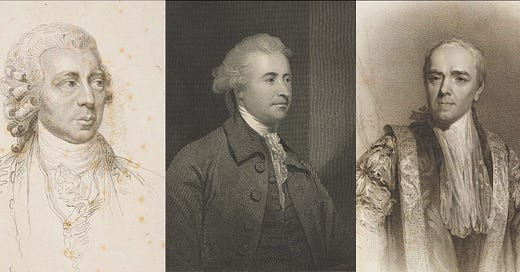0. Prologue (start here)
A woodland meeting with Edmund Burke, philosopher and statesman
The Dick family - Eliza’s paternal line - has its own dynastic foundation story: it begins with a chance meeting between a farmer’s daughter and two prominent statesmen in a wood near Pitlochry. There are two versions, each slightly different, but their common parts have a ring of truth. In the first, two Westminster MPs, Edmund Burke and William Windham, are embarking on a walking tour of the Highlands.
This would have been in around 1778, when the American revolutionary war was in full swing; in London, Sheridan’s School for Scandal had its first performance; in Paris, Loivoisier identified and isolated Oxygen; France declared war on England and its troops were besieged in Pondicherry in India — an early global war; in Derby, Richard Arkwright had developed a factory system for weaving cotton; in Calcutta, Nathaniel Halhed’s Grammar of the Bengali language was the first book to be printed in both Bengali and Latin typefaces; in Edinburgh and Perth, a West African man, Joseph Knight, won two appeals in the courts against a Scot who claimed to own him, and he became a free man: Henry Dundas and James Boswell contributed to his defence.
Before setting out, Burke and Windham enjoyed dinner in Edinburgh at the home of the economist and philosopher Adam Smith. A fellow diner, Sir John Sinclair, recommended they walk via Dunkeld and through the woods to Blair Atholl, which they did and where they met (and Wyndham fell for) ‘a beautiful mountain-nymph’; she was the daughter of a local farmer, self-styled ‘Baron’ MacLaren. Some months later Windham, confronting Sinclair behind the Speaker’s chair in the House of Commons, demanded that he ascertain whether she was married or single.
“Sinclair did as he was asked, discovering that she was married to a medical gentleman of the name of Dick, who had gone to the East Indies.’ Upon communicating this to Mr Windham, “he seemed very much agitated”, deprived, as Sinclair put it, “of his Northern Alliance”.

Subsequently, Sinclair told this elaborate story to Henry Dundas at a meeting at which the Prime Minister William Pitt and ‘the beautiful Miss Duncan’ were also present.1 Dundas was Pitt’s political fixer in Scotland, his eyes on the ground and troubleshooter; he added his own twist to the story by claiming to have met the very same ‘most beautiful young woman’ while riding down from Blair to Dunkeld. She had desired to speak to him: ‘Mr Dundas, I hear that you are a very great man, and, what is much better, a very good man. ….There is a young man in this neighbourhood who has a strong attachment to me, and, to confess the truth, I have a great regard for him. His name is William Dick; he has been bred to the medical profession, and he says, that if he could get to be a surgeon in the East Indies, he would soon make his fortune there, and would send for me to marry him,….we shall be ever grateful if you can procure him an appointment.’2
And this Henry Dundas did. He was, after all, a notorious place-monger, distributing his patronage of covenanted East India positions to ranks of the high and middling Scottish gentry in return for their support for Pitt’s government in London.3
In another version that brings the two stories together, Burke’s companion is not Windham but Henry Dundas himself; the pair were staying with the Duke of Atholl at Dunkeld, “where they accidentally met a farmer's daughter, who gave them refreshment during a walk” - then, as before, Dundas gave her fiancée Dick an assistant-surgeoncy in the East India Company's service. “Dick at once married and went to India, where he soon made a large fortune, with which he retired and purchased the estate of Tullimet”.4 Sir John Sinclair, in his retelling, described this story as ‘one of the most singular series of adventures that ever occurred in real life, and resemble(s) more a fictitious romance than an authentic history.’
Perhaps so: the reality was indeed a little more complicated, but without altering the simple truth that luck and judgement together have the potential to change many lives, over many generations.5
© William Owen 2024 - All rights reserved
This was Jane Duncan, who later married Sir Hew Dalrymple Hamilton.
The London and Paris Observer, which adds: “In the course of the voyage, and after her arrival in the East, she had several offers, but she refused to hear of any one but Dr. Dick.” See also, The Correspondence of John Sinclair.
Dundas was not yet appointed President of the Board of Control that gave Government oversight of East India Company affairs, but he was already a powerful man as Lord Advocate and Keeper of the Signet and, more importantly, William Pitt’s factotum in Scotland.
Dictionary of National Biography 1885-1900 Vol 15 by Henry Morse Stephens. Also The Gentleman’s Magazine, May 1846 (obituary of Major General Sir Robert Henry Dick)
East India Company records give two conflicting dates for Dr Dick’s arrival in India. The Bengal section of the Roll of the Indian Medical Services gives a data of 1778-79, with Dick as surgeon’s mate of the Queen; the Prince of Wales Island section in the same volume gives a date of 1781, when Dick was Assistant Surgeon on the same vessel, having received his Certificate of Corporation of Surgeons in 1780. A large number of surgeons were recruited in 1781, during the Maratha and Maisur wars, and their were constant disputes between these officers as to seniority. Dick is recorded as first in that year. It’s not inconceivable that Dick arranged for his post to be back-dated, in order to gain rank.




